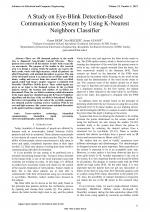| 1/2023 - 8 |
A Study on Eye-Blink Detection-Based Communication System by Using K-Nearest Neighbors ClassifierEKIM, G. |
| Extra paper information in |
| Click to see author's profile in |
| Download PDF |
Author keywords
assistive technology, biomedical communication, biomedical signal processing, electroencephalography, machine learning
References keywords
brain(9), communication(7), interface(6), writing(5), system(5), efficient(5), typing(4), time(4), text(4), systems(4)
Blue keywords are present in both the references section and the paper title.
About this article
Date of Publication: 2023-02-28
Volume 23, Issue 1, Year 2023, On page(s): 71 - 78
ISSN: 1582-7445, e-ISSN: 1844-7600
Digital Object Identifier: 10.4316/AECE.2023.01008
Web of Science Accession Number: 000937345700008
SCOPUS ID: 85150264613
Abstract
There are 450 thousand patients in the world who is diagnosed Amyotrophic Lateral Sclerosis. These patients lose control of all the muscles in their body except the eye movements. The purpose of the studies in this research area is to design a system, which the patients can express the basic needs, works with high accuracy, which all patients can afford financially, with minimal discomfort to person. The aim of the developed system is to analyze the eye-blinks made with binary coding and convert them into sound. First, eye-blink signals coded with binary number sequence is obtained with NeuroSky MindWave Mobile device. These coded signals are given as an input to the designed system. In the eye-blink analysis section, the location and number of eye-blinks are determined. Then, the eye-blinks containing coded information in the input signal are classified using the K-Nearest Neighbors algorithm, and the class of the eye-blink is determined. Finally, the letters corresponding to the code of the eye-blink sequence are obtained and the resulting word is vocalized. With its low cost and high accuracy, this system causes minimal discomfort to the patient and has a simple structure. |
| References | | | Cited By |
Web of Science® Times Cited: 2 [View]
View record in Web of Science® [View]
View Related Records® [View]
Updated 3 weeks, 5 days ago
SCOPUS® Times Cited: 4
View record in SCOPUS® [Free preview]
View citations in SCOPUS® [Free preview]
[1] A Novel Approach on Converting Eye Blink Signals in EEG to Speech with Cross Correlation Technique, IKIZLER, N., EKIM, G., ATASOY, A., Advances in Electrical and Computer Engineering, ISSN 1582-7445, Issue 2, Volume 23, 2023.
Digital Object Identifier: 10.4316/AECE.2023.02004 [CrossRef] [Full text]
[2] Design recommendations for voluntary blink interactions based on pressure sensors, Fan, Lin-Han, Huang, Wei-Chi, Shao, Xue-Qi, Niu, Ya-Feng, Advanced Engineering Informatics, ISSN 1474-0346, Issue , 2024.
Digital Object Identifier: 10.1016/j.aei.2024.102489 [CrossRef]
[3] EEG Based Communication System by Using Artificial Neural Networks, Ekim, Gunes, Ikizler, Nuri, Atasoy, Ayten, 2023 Medical Technologies Congress (TIPTEKNO), ISBN 979-8-3503-2896-7, 2023.
Digital Object Identifier: 10.1109/TIPTEKNO59875.2023.10359177 [CrossRef]
Disclaimer: All information displayed above was retrieved by using remote connections to respective databases. For the best user experience, we update all data by using background processes, and use caches in order to reduce the load on the servers we retrieve the information from. As we have no control on the availability of the database servers and sometimes the Internet connectivity may be affected, we do not guarantee the information is correct or complete. For the most accurate data, please always consult the database sites directly. Some external links require authentication or an institutional subscription.
Web of Science® is a registered trademark of Clarivate Analytics, Scopus® is a registered trademark of Elsevier B.V., other product names, company names, brand names, trademarks and logos are the property of their respective owners.
Faculty of Electrical Engineering and Computer Science
Stefan cel Mare University of Suceava, Romania
All rights reserved: Advances in Electrical and Computer Engineering is a registered trademark of the Stefan cel Mare University of Suceava. No part of this publication may be reproduced, stored in a retrieval system, photocopied, recorded or archived, without the written permission from the Editor. When authors submit their papers for publication, they agree that the copyright for their article be transferred to the Faculty of Electrical Engineering and Computer Science, Stefan cel Mare University of Suceava, Romania, if and only if the articles are accepted for publication. The copyright covers the exclusive rights to reproduce and distribute the article, including reprints and translations.
Permission for other use: The copyright owner's consent does not extend to copying for general distribution, for promotion, for creating new works, or for resale. Specific written permission must be obtained from the Editor for such copying. Direct linking to files hosted on this website is strictly prohibited.
Disclaimer: Whilst every effort is made by the publishers and editorial board to see that no inaccurate or misleading data, opinions or statements appear in this journal, they wish to make it clear that all information and opinions formulated in the articles, as well as linguistic accuracy, are the sole responsibility of the author.



